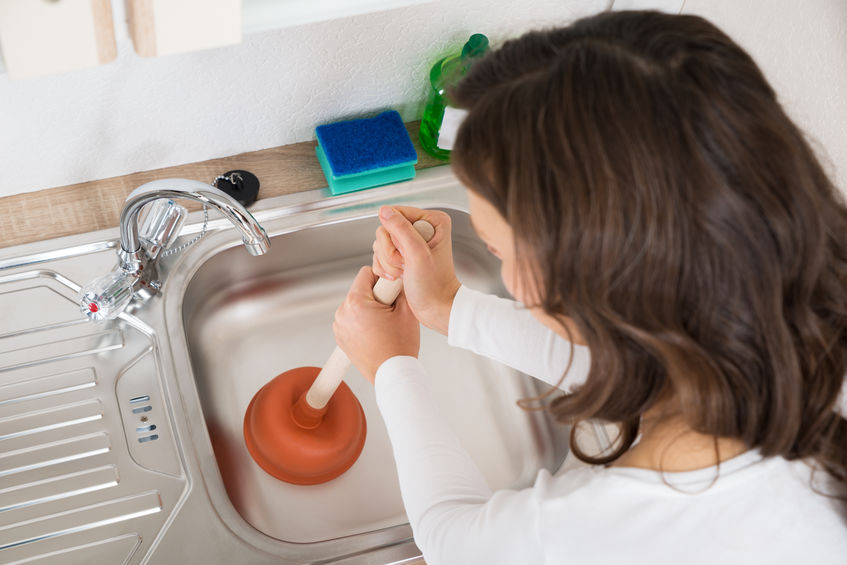 A clogged kitchen sink can be a big nightmare for you. With a counter full of dirty dishes and water not draining, it can be tempting for you to reach out to a plumber to come and assist. Before you do so, you might want to try out some DIY ways to unclog your kitchen sink. Luckily, this is not tough and with some simple tools and determination, you should be done in no time. This article looks at how to unclog a kitchen sink, and prevent clogs in the future.
A clogged kitchen sink can be a big nightmare for you. With a counter full of dirty dishes and water not draining, it can be tempting for you to reach out to a plumber to come and assist. Before you do so, you might want to try out some DIY ways to unclog your kitchen sink. Luckily, this is not tough and with some simple tools and determination, you should be done in no time. This article looks at how to unclog a kitchen sink, and prevent clogs in the future.
How to Unclog a Kitchen Sink
Here are some easy methods to unclog a kitchen sink:
Boiled Water
This is probably the easiest solution of all, making it a must try. Heat some water using a kettle or pot, and as you wait for it to boil, remove as much water from the sink as possible. Afterward, pour the boiled water into the sink. If you are dealing with a simple clog, this solution should solve your problem quite easily.
Vinegar and Baking Soda
Remove the standing water using a mug, and then pour a handful of baking soda into the drain, followed by a good amount of apple cider vinegar. Doing this will lead to a bubble. When it subsides, put the stopper in and wait for about 20 minutes. Run hot water through the sink and see if the clog clears.
Plunger
If the aforementioned techniques are not successful, consider using a plunger to unclog the sink. If you use a double sink, you will need to seal the second side with a stopper. Create a tight seal around the plunger by filling the sink you want to plunge with enough water to cover the plunger’s bell. Afterward, place the plunger over the sink drain and plunge several times. If the method works, you will hear the suction clear the clog.
The Bent Wire Hanger
Take a normal hanger and straighten it out as much as you can. Later, bend one side over to create a hook and push it through the drain. You should be able to come out with all sorts of gunk. While doing this, you should be careful not to push the nasty stuff further down instead of removing it. When you have retrieved as much as you can, run down the water, and it should flow without any issues.
How to Prevent Future Kitchen Sink Clogs
The aforementioned methods will help you unclog your kitchen sink. Nevertheless, it is good to know how to prevent clogs in the future. Here are some tips for you:
Pour Hot Water at Least Once
You should pour hot water down the drain at least once every week. Small amounts of food and fats can get into the drain, and pouring hot water will help prevent any future blockages. Heat some water in a pot or kettle and pour it slowly down the sink drain.
Do not Pour Oil or Grease Down the Drain
Pouring hot fat down the sink drain is not advisable, as it congeals and settles in pipes. The best way to do this is to let fats and oils cool down, and then place the solid fat into the garbage disposal bin.
Use a Drain Strainer
It is important not to let food scraps go down the drain, and a drain strainer can help you with that. Get a drain strainer ideal for your sink and implement it to collect food scraps.
Do not Let Tea leaves Run Down the Sink Drain
If you let tea leaves down the sink drain, they will accumulate and clog the S-bend. Therefore, you should never let tea leaves go down the drain. Instead, consider throwing them in the trash.
If you begin to notice that your sink drain takes longer to drain, or there are unpleasant odors coming from it, it might be a sign that your sink is clogged. You need to handle this issue quickly before your sink drain blocks completely. This article has provided you with tips on how you can unclog your kitchen skin drain, and prevent the problem altogether. With this information, you should be well positioned to handle any sink clogs that come your way. Nevertheless, it is understandable that you might not have the time, expertise, or willpower to unclog your sink drain. Due to this, you might want to contact a professional to handle your problem and advice you on the best way to prevent such problems in future.
